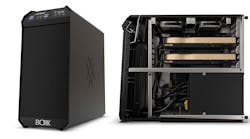Small to Medium-sized Businesses (SMB) make up nearly all of the metalcasting market. While the definition of SMB varies, a good range for the metalcasting industry would be: Small, 1 to 49 employees; medium (low-end range), 50 to 249 employees; medium (high-end range), 250 to 499 employees; large, 500 and more employees.
Most SMBs, and indeed most metalcasting companies, are privately held, with ownership spanning multiple generations, and are business focused on niche markets or discrete set of customers. SMB also tend to concentrate their resources on their core business objectives— in this case, providing high-quality castings, engineering services, etc. They do not have the luxury of expending extensive resources on IT systems and infrastructure - resources for not only the initial purchase, but also the often underestimated, ongoing costs (product and people) associated with maintaining high-end computer hardware and software systems. This is why “the Cloud” is such a significant development for these businesses.
But first, what does the term “cloud” mean in this discussion? The National Institute of Standards and Technology (NIST) defines cloud computing as “a model for enabling ubiquitous, convenient, on-demand network access to a shared pool of configurable computing resources (e.g., networks, servers, storage, applications, and services) that can be rapidly provisioned and released with minimal management effort or service provider interaction.” This is a more formal way of saying, “accessing information systems through an Internet connection.”
Why is the Cloud such an important development for metalcasters? It allows small and medium-sized metalcasters to realize the benefits and power of integrated business systems, historically reserved for much larger organizations, at a relatively reasonable cost, without the IT resource requirement, meaning both the initial investment cost as well as the ongoing operating and maintenance costs. Business systems operating in the Cloud offer the following benefits:
• No cost to purchase and maintain computer hardware components;
• No cost to purchase and maintain computer software systems (operating and applications);
• No need to manage daily backups, database tuning and other system maintenance;
• No need to implement and manage disaster recovery technology;
• No need to invest in or to monitor and maintain security, anti-virus, anti-ransomware systems.
The advantages go beyond cost, however. Cloud-based business systems enable small and medium-sized metalcasters to implement feature-rich, robust, integrated application software for a fraction of the cost of a few years ago. If implemented properly and fully endorsed by all levels of management, these systems can significantly improve customer service, on-time delivery, product quality, inventory reductions, cash flow, and numerous other business system improvements, according to the specific needs of your organization. And, all that the business needs to make these advantages available is an Internet connection and web browser to access the system — which can be done anytime, anywhere, from any device.
What kinds of business systems are deployed in the Cloud? Just about all major categories of business software are performing effectively in the Cloud, including:
• CRM – Customer Relationship Management,
• SCM – Supply Chain Management,
• HRC – Human Resource Capital (including Payroll functions),
• ERP – Enterprise Resource Planning (including Financials), and
• MES – Manufacturing Execution Systems.
One of the more exciting aspects of Cloud-based business software implementation involves shop-floor management systems. You might think there is limited application for linking your manufacturing equipment, e.g. diecasting machines, moldmaking and coremaking machines, etc., but actually the ability to monitor activity, adjust set points, diagnose errors and fix problems, either by the machine supplier or the casting producer, creates a more immediate and cost-effective solution. Also, by coordinating these work centers in the Cloud, it is easier to establish interfaces for them with other cloud-based systems.
Easy Integration, Instant Awareness
For example, a diecasting machine monitoring system in the Cloud would be very easy to interface with an ERP system in the Cloud, providing instantaneous awareness of shot count, good pieces, scrap pieces, etc. all with a simple Internet connection, at anytime, from anywhere, with any device.
But, what if Cloud computing products and services are just a fad? Today’s business journals are filled with pertinent facts forming an argument that Cloud capabilities provide SMBs with more opportunities to improve capabilities and performance:
• In “Why your company may dump QuickBooks this year,” for Forbes, author Gene Marks offers the argument that on-premises software is quickly becoming an artifact of the past, especially for small and medium-sized businesses (SMB). “The Cloud has caught up to the accounting and ERP world,” Marks writes, “and there are many competitors to QuickBooks standing by ready to pounce.”
• Cloud based ERP software is expected grow 10% annually for the period 2014-2020. On the far horizon of the business software world, venture capitalists are not investing in companies that are not established in the Cloud. According to Inacct CEO Robert Reid, “VCs are not investing in on-premise software companies anymore.
“In the next few years it’s inevitable that you’re going to replace your on-premise QuickBooks system for something cloud-based,” he predicted, adding for emphasis: You won’t have much of a choice. And you’re going to take that opportunity to look around. And you’re going to discover there are some interesting alternatives.”
• According to a survey by Gartner, a research firm that specializes in the IT sector, 47% of small and medium-sized business have moved or will move their core ERP software to the Cloud by 2019.
InformationWeek's 2014 State of Cloud report found that 64% of companies (all with 50 or more employees) using some form of cloud technology. Companies' widespread embrace of the Cloud-- seem ready to finally bring ERP into the fold in the coming years.
In Forbes’ “Roundup Of Small & Medium Business Cloud Computing Forecasts And Market Estimates, 2015” Louis Columbus reported that: 78% of American small businesses will have fully adopted cloud computing by 2020, more than twice the current rate of 37%.
As with any new technology, there are some implementation questions. Two concerns commonly raised when considering a Cloud ERP solution are 1) Access Reliability and 2) Data Security. These points should be addressed by any business considering any software in the Cloud:
1. Access Reliability
• What level of redundancy is built into the server hardware at the data center?
• Should a system component fail at the data center, how “fresh” will the data be after it’s restored?
• What level of redundancy is built into the power feeding the data center?
• What level of redundancy is built into the network (Internet lines) feeding the data center?
• What is the disaster recovery plan should the data center experience “an event”?
• Does the Cloud ERP provider offer an uptime guarantee?
• Does my local ISP (Internet Service Provider) offer an uptime guarantee?
• What options do I have if my local ISP goes down, e.g. redundant line, hotspot, etc.
2. Data Security
• Who has access to the data center?
• What is the physical data center security, e.g. key card, biometric, video, security staff, etc.?
• What level of firewall protection is provided?
• Can email attachments be opened on the Cloud servers?
• Is Denial of Service (DOS) protection enabled?
The appropriate party providing the service should answer all of these questions adequately. The technology exists to address these concerns and most reputable providers have addressed these issues, and then some. Realistically, an SMB would find it difficult, if not impractical, to build and maintain a world-class data center where most Cloud ERP providers house and serve up their systems.
In summary, SMBs are moving their business systems to the Cloud at an increasing rate. The majority of these companies have concluded the benefits far outpace the risks in this decision.
Philip Laney is the chief executive officer of B&L Information Systems. Contact him at [email protected]









